| SOCIETY |
| INDENHOFEN FARM |
| SKIPPACK HISTORY |
| REVOLUTIONARY WAR |
| ARCHITECTURE |
| CREAMERY VILLAGE |
| LINKS |
Kidder-DeHaven Society Van Vlecq's records of the German Reformed Church of Whitemarsh in 1710 Recorded Deed, Book E, Vol. 6, page 40 Recorded Deed, Book G, page 391 The Montgomery Transit, July 10, 1896 Vol IX, No. 3, History of Skippack by James Y. Heckler. In order to continue maintaining and restoring the Historic Indenhofen Farm at the corner of Skippack Pike and Evansburg Road in Skippack we need help from the community.
We are a 501(c)(3) Tax Exempt Organization! |
| ABOUT | SUPPORT | UPCOMING | IN THE NEWS |
| Indenhofen Farm |
LOCATED IN EVANSBURG STATE PARK
As we put together a history of this old house and learn about the people who lived there, we also become aware of the history of the Skippack Village.
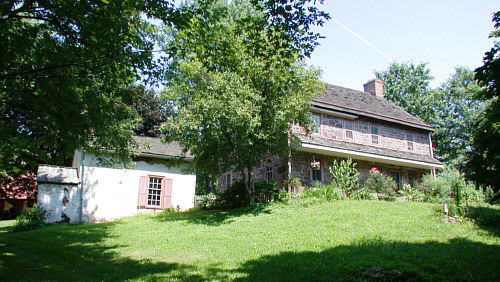
German immigrants Gerhard Indenhofen and his brother Herman built this house around 1725. Gerhard was 19 years old when the boys purchased 440 acres from Mathias Van Bebber in 1706. The original deed (Phila. Book E3 6:40, 24, Oct. 1706, 440ac., 88 £-s) indicates that this encompassed the whole village of Skippack. The stone was carried from quarries along the Skippack Creek a little south of the house. The mortar was a simple mixture of Skippack red clay and lime held together by horse hair and rope and sometimes straw. Looking at the inside of the house, these rudimentary ingredients seem to be doing a decent job of holding the stones in place even today.
 Gerhard IndenHofen was born in 1687 in Mulheim, Germany on the Ruhr River.1 Mulheim is located in northwest Germany near the border of Holland. Research indicates that this is the area of the old world that many of our early Skippack settlers come from. Gerhard arrived in America with his father (Eberhardt) and mother (Elizabeth nee' Schipboucher), two brothers (Peter and Harman) and a sister (Anneke) sometime in 1698.2 Based on primary church records, the IndenHofens settled in Whitemarsh (Wide Marsh), Pennsylvania.3
Gerhard IndenHofen was born in 1687 in Mulheim, Germany on the Ruhr River.1 Mulheim is located in northwest Germany near the border of Holland. Research indicates that this is the area of the old world that many of our early Skippack settlers come from. Gerhard arrived in America with his father (Eberhardt) and mother (Elizabeth nee' Schipboucher), two brothers (Peter and Harman) and a sister (Anneke) sometime in 1698.2 Based on primary church records, the IndenHofens settled in Whitemarsh (Wide Marsh), Pennsylvania.3
On October 8, 1706, Gerhard and his brother Herman bought 440 acres in Skippack from Mennonite Mathias Van Bebber for a consideration that is not mentioned in the deed.4 The brothers separated on May 2, 1723, Gerhard kept the property in Skippack and Herman moved to Lower Providence.5
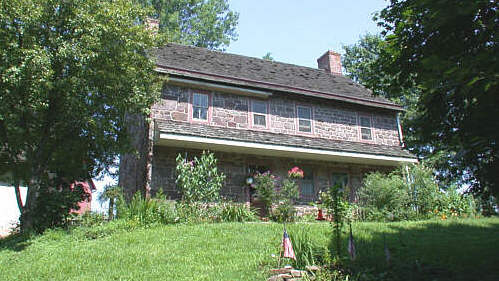
The house was built circa 1725 and bears resemblance to a few of the other early houses along the Skippack Creek in the stonework signature. In 1736 Gerhard had a grist mill built on the property that he rented to Felix Good. In 1743, he applied for a license to keep a "public house" 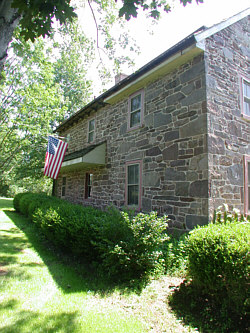 and also let the house be used as the Skippack Reformed Church for Sunday morning meetings. In 1746, Gerhard died from an apparent flu epidemic and the house went to the oldest living mail grandchild, 9 year old Peter Keiter.6
and also let the house be used as the Skippack Reformed Church for Sunday morning meetings. In 1746, Gerhard died from an apparent flu epidemic and the house went to the oldest living mail grandchild, 9 year old Peter Keiter.6
In 1783, Peter Keiter put an addition on to the house, almost doubling its size and that's the way it looks from the outside today.
The house has had 17 owners in the past 270 years and these occupants made little effort to remodel or change the structure.

General George Washington and his 10,000 continentals marched past in 1777 to camp along the Skippack Creek and probably gazed upon this stone house only it was about half this size.
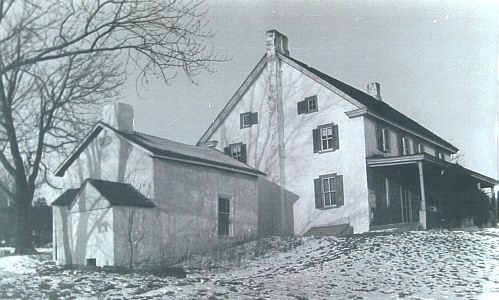
Above is a photo taken of the Indenhofen Farm House before restoration work by the Skippack Historical Society began. The summer kitchen is on the left and the main house on the right.
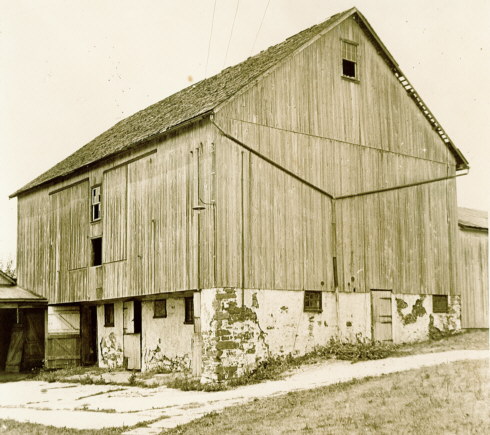
Above is a photo of the Indenhofen Barn taken around 1970 before we begun the restoration.
Move mouse over footnote numbers above to display sources.
Property owned by the Commonwealth of Pennsylvania
Department of Conservation & Natural Resources
Bureau of State Parks and Evansburg State Park